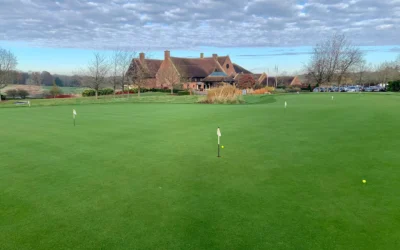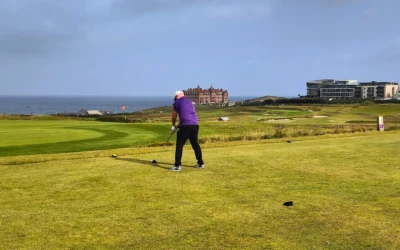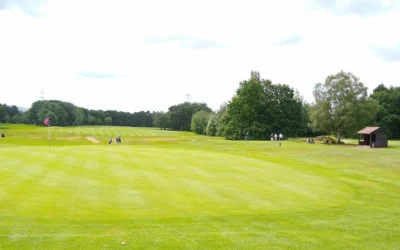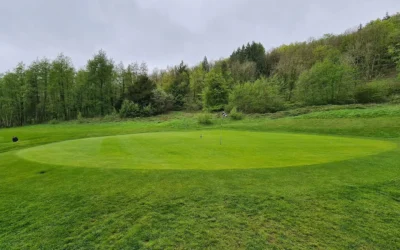Royal Worlington And Newmarket Golf Club
Royal Worlington And Newmarket Golf Club (Worlington, Suffolk, England)
Nestled in the tranquil Suffolk countryside, Royal Worlington & Newmarket Golf Club, fondly known as the “Sacred Nine,” is a nine-hole masterpiece that captivates golfers with its timeless charm. Set on gently undulating sandy soil, this course is celebrated as one of the world’s finest nine-hole layouts, a claim supported by its consistent ranking among Britain’s top 100 courses. Its fast, firm greens and strategic design evoke the spirit of St. Andrews, challenging players to think creatively.
As you stand on the first tee, you’re not just playing golf—you’re stepping into a legacy shaped by over a century of tradition, where Cambridge University golfers and legends like Harry Colt have left their mark.
Key Details
- Location: Worlington, Suffolk, England
- Length: 3,155 yards (from championship tees for nine holes)
- Par: 35
- Designers: Tom Dunn (original, 1893), Harry Colt (modifications, 1920s)
- Established: 1893
- Notable Events: Home to Cambridge University Golf Club, hosts annual Varsity Match against Oxford
History and Significance
The origins of Royal Worlington & Newmarket trace back to 1890, when William Gardner, Col E W D Baird, and Alexander Mackenzie Ross first played golf on its sandy terrain. The club was formally established on May 18, 1893, with 20 founding members, many tied to Newmarket’s horseracing scene. In 1895, the Prince of Wales (later King Edward VII) became president, and Queen Victoria granted the “Royal” title, cementing its prestige. Tom Dunn designed the original layout, initially planning 18 holes, but the nine-hole course on sandy soil became its enduring identity.
The course evolved significantly in the early 1920s under Harry Colt’s guidance. Colt, a Cambridge Blue Captain, lengthened the 8th hole and redesigned the 9th, enhancing the course’s strategic depth. These changes ensured its relevance as golf equipment advanced, maintaining its challenge and charm. The club’s connection to Cambridge University Golf Club (CUGC), which began using the course in 1901, has been a cornerstone of its identity. The annual Varsity Match against Oxford, held in March, is a cherished tradition.
Royal Worlington’s historical significance is amplified by iconic moments and figures. Bernard Darwin, a revered golf writer, dubbed it “The Sacred Nine” in 1928, a name that resonates globally. The course has hosted countless amateur golfers, with its greens shaping the skills of university players. Modern architects like Tom Doak have praised its design, scoring it 9/10 for its outstanding use of land.
Culturally, Royal Worlington stands as a beacon of golfing heritage. Its consistent top-100 rankings in Britain and Ireland, coupled with endorsements from golfing luminaries, underscore its global influence. The course’s compact yet brilliant design has inspired architects and players, proving that quality trumps quantity. As one reviewer noted, “There seems more history per hole than at any other club in England.”
Course Features
Royal Worlington & Newmarket is a nine-hole inland links-style course set on sandy, well-draining soil, ensuring playability in all seasons. Its gently undulating terrain creates a natural rhythm, with each hole offering distinct challenges. The course maximizes its compact 3,155-yard layout through clever design, including shared fairways and tee shots over greens.
The course’s hallmark is its exceptional green complexes, considered among England’s finest. These greens feature bold contours—random rolls on the 1st, a crowned 2nd, the treacherous 5th, and a side-sloping 9th—demanding precision and imagination. The sandy soil produces firm, fast conditions, encouraging a ground game akin to coastal links. Strategic elements, like a public road crossing the 9th fairway, add quirkiness and challenge.
Challenges abound, from half-par holes that keep players guessing to greens that punish errant shots. The course’s lack of heavy reliance on bunkers “
or rough highlights its reliance on natural contours and green complexity for defense. Scenic beauty is subtle yet captivating, with the sandy landscape and open Suffolk vistas providing a serene backdrop. Golfers often compare the experience to a journey back in time, where every shot feels like a dialogue with golf’s past.
Signature Holes
Hole 5 (Par 3, 160 yards)
Widely regarded as one of the greatest par-3 holes outside the United States, the 5th is a masterpiece of design. Its long, narrow green spans 26 paces and features three distinct levels, flanked by “Mog’s Bog” on the left and a stream on the right. Hitting the correct level is crucial, as the severe slopes can turn a simple putt into a nightmare. This hole’s reputation was cemented by praise from architects like JSF Morrison, who called it a standout.
Hole 9 (Par 4, 290 yards)
The closing hole is a short, tantalizing par 4 that tempts golfers to drive the green. The drive must carry a boundary, and the green’s pronounced left-to-right slope makes holding it tricky. With no bunkers to the left, the hole relies on its natural contours for defense. It’s a fitting finale, blending risk and reward, and has been a stage for dramatic finishes in university matches.
Hole 4 (Par 5, 490 yards)
Lengthened by Harry Colt in 1920, this par 5 shares its fairway with the 6th, adding strategic intrigue. The green complex rises before sloping sharply away, making approach shots a test of nerve. Its historical significance and demanding design make it a favorite among players, often cited for its ability to reward bold play while punishing mistakes.
Why Visit
Royal Worlington & Newmarket offers a golfing experience that blends challenge, history, and beauty. Its nine holes test every facet of a golfer’s game, from precise drives to delicate putting on its fiendish greens. The course’s compact layout ensures a round is both engaging and time-efficient, typically taking just over an hour, yet leaves players craving another loop.
The emotional resonance of playing the “Sacred Nine” is profound. Golfers walk fairways where Cambridge University players have competed for over a century, connecting to a legacy that includes Harry Colt and Bernard Darwin. Tom Doak’s endorsement—“outstanding” with a 9/10 rating—reflects its universal appeal. The course’s historical anecdotes, like Darwin’s poetic praise, add depth to every shot.
Practically, the club’s welcoming clubhouse and practice facilities enhance the visit. Its proximity to cultural hubs like Cambridge and Newmarket makes it an ideal stop on a golfing tour. As one golfer noted, “It’s a course that tests your soul and rewards your heart.”
Facilities
The clubhouse at Royal Worlington is a cozy haven, steeped in tradition. It features a dining area serving local Suffolk cuisine, a pro shop with golf essentials, and lounge spaces for post-round relaxation. The staff’s hospitality ensures a warm welcome for visitors.
Practice facilities include a driving range and putting green, perfect for warming up or refining skills. The club offers caddy services and golf lessons, catering to players seeking to improve. Locker rooms and additional amenities provide comfort, making the club a well-rounded destination for golfers.
Contact Details and Directions
- Address: Golf Links Road, Worlington, Bury St Edmunds, Suffolk, IP28 8SD, England
- Phone: +44 (0)1638 717787
- Email: secretary@royalworlington.co.uk
- Directions: Located 10 miles from Bury St Edmunds and 15 miles from Cambridge, it’s a 1.5-hour drive from London via the M11 and A11.
- Public Transport: Trains to Bury St Edmunds, followed by a taxi or bus to Worlington.
- Parking: Ample on-site parking available.
- Map: View on Google Maps
Green Fees and Booking
Green fees at Royal Worlington vary by season and day. As a private club, visitor access is limited, and all bookings must be arranged in advance. Contact the Secretary via phone or email for pricing and availability. A typical pricing structure might look like this:
|
Season |
Non-Resident (Before 1pm) |
Non-Resident (After 1pm) |
Hotel Guest |
|
Apr–Oct |
£100 |
£75 |
£60 |
|
Nov–Mar |
£75 |
£60 |
£50 |
- Membership Options: Available; inquire with the club.
- Booking Process: Book via phone (+44 (0)1638 717787) or email (Royal Worlington).
- Requirements: Smart golf attire required; handicap certificates may be requested.
Nearby Attractions
Suffolk’s rich heritage and natural beauty complement a visit to Royal Worlington. From historic sites to outdoor adventures, there’s something for everyone.
|
Attraction |
Appeal |
Distance |
|
Newmarket Racecourse |
Historic horse racing tours |
8 miles |
|
Bury St Edmunds |
Abbey, gardens, dining |
10 miles |
|
Cambridge |
University, punting, museums |
15 miles |
|
Thetford Forest |
Walking, cycling trails |
20 miles |
|
Ickworth House |
National Trust estate, gardens |
12 miles |
|
Ely Cathedral |
Stunning medieval architecture |
18 miles |
|
Lavenham |
Picturesque medieval village |
22 miles |
|
Anglesey Abbey |
Historic house, gardens |
14 miles |
- Newmarket Racecourse: Explore the heart of British horse racing with guided tours.
- Bury St Edmunds: Wander through abbey ruins and enjoy vibrant markets.
- Cambridge: Punt along the River Cam and visit historic colleges.
- Thetford Forest: Ideal for outdoor enthusiasts with extensive trails.
- Ickworth House: A National Trust gem with parkland and gardens.
Frequently Asked Questions (FAQs)
How do I book a tee time?
Bookings must be made in advance via phone (+44 (0)1638 717787) or email (Royal Worlington).
What are the green fees?
Fees vary by season; contact the club for current rates.
Is the course suitable for beginners?
It’s challenging but enjoyable for all levels, though some experience helps.
What’s the best time to play?
Year-round playability, with spring and summer offering ideal weather.
What’s the dress code?
Smart golf attire is mandatory; confirm specifics with the club.
Are practice facilities available?
Yes, a driving range and putting green are provided.
How do I get there?
Drive 1.5 hours from London via M11/A11 or take a train to Bury St Edmunds.
Are there nearby courses?
Suffolk and Cambridgeshire offer several golf options.
What tournaments are hosted?
Home to Cambridge University Golf Club and the Varsity Match.
Why is it called the “Sacred Nine”?
Bernard Darwin coined the term in 1928 for its exceptional quality.
Is accommodation available?
No on-site lodging; nearby hotels in Bury St Edmunds or Cambridge.
Is membership offered?
Yes, contact the club for membership details.
What’s the weather like?
Temperate climate; mild summers, cool winters with occasional rain.
Can I hire clubs or a caddy?
Club hire and caddy services may be available; inquire with the club.
What makes the course unique?
Its nine-hole brilliance, historical ties, and challenging greens.
Enville Golf Club Lodge Course
Enville Golf Club Lodge Course (Enville, West Midlands, England) Enville (Lodge) Golf Course, nestled in the picturesque West Midlands of England, offers golfers a unique blend of challenging play and natural beauty. Located in the heart of Staffordshire, this course...
London Golf Club International Course
London Golf Club International Course (Ash, Kent, England) Nestled in the picturesque countryside of Kent, just a short drive from London, London Golf Club International Course is a haven for golf enthusiasts. Picture yourself on the first tee, gazing across rolling...
Newquay Golf Club
Newquay Golf Club (Newquay, Cornwall, England) Nestled along the rugged coastline of Newquay, Cornwall, England, Newquay Golf Club is a beacon of links golf’s enduring charm. Established in 1890 and re-designed by the legendary Harry Colt, this 18-hole course...
Stockport Golf Club
Stockport Golf Club (Stockport, Greater Manchester, England) Nestled in the heart of Greater Manchester, Stockport Golf Club is a beacon of golfing heritage and natural splendor. Founded in 1905, this championship-standard course invites golfers to step onto fairways...
Golf At Goodwood
Golf At Goodwood (Chichester, West Sussex, England) Nestled within the sprawling 12,000-acre Goodwood Estate in West Sussex, England, Goodwood Golf Course offers an unparalleled golfing experience that blends history, natural beauty, and championship-level challenge....





